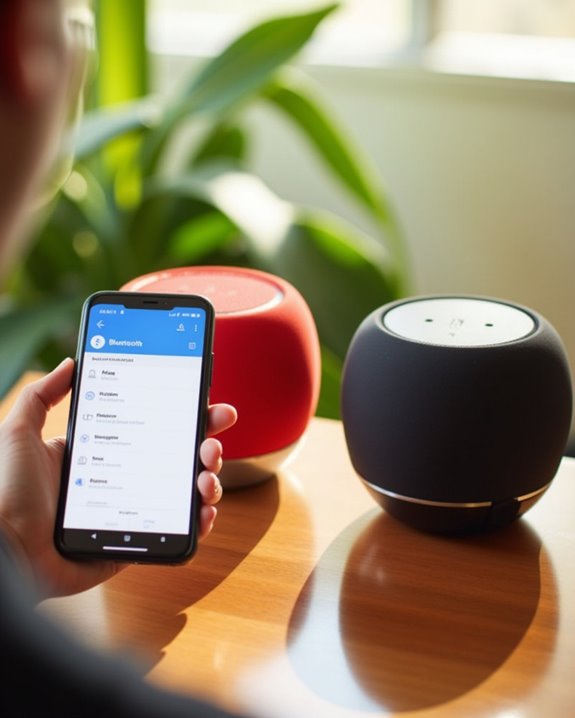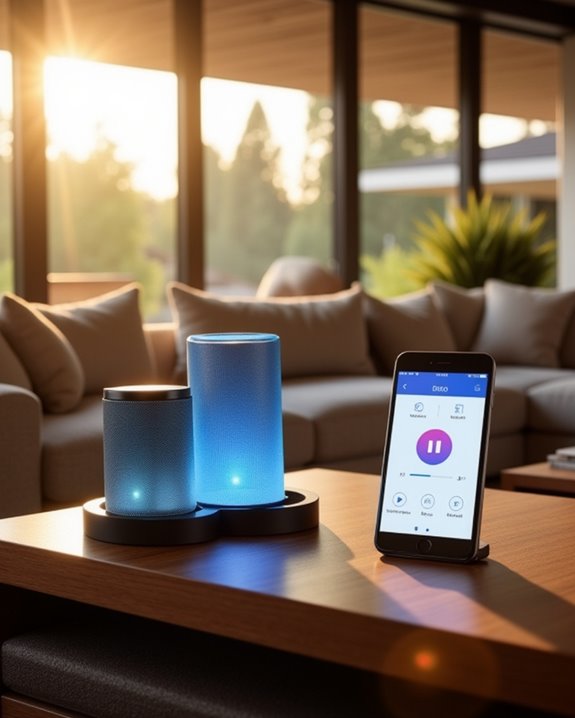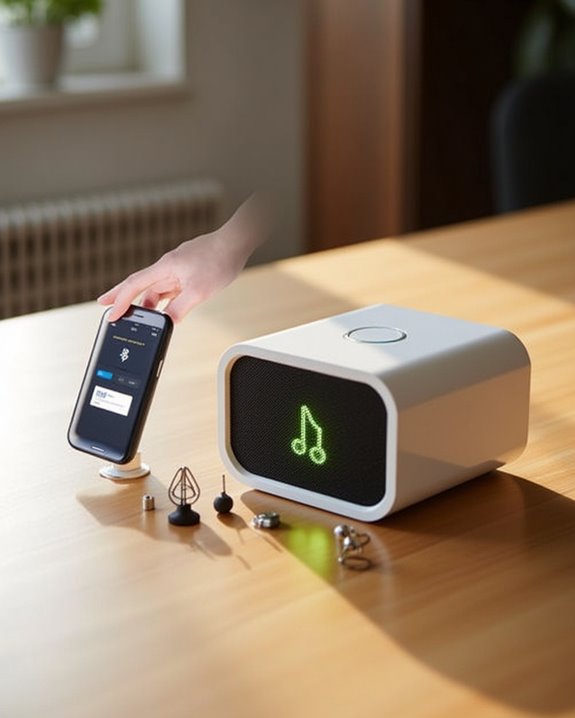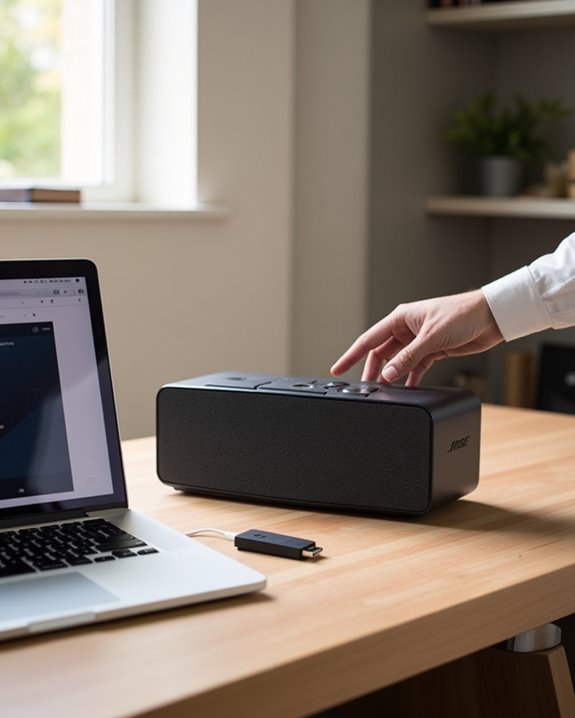Connecting multiple Bluetooth speakers requires a three-step approach. First, verify compatibility by ensuring speakers support multi-device connections via branded features like Party Mode or Stereo Pair, preferably from the same manufacturer. Next, establish the primary connection by activating pairing mode on your main speaker and connecting through your source device’s Bluetooth settings. Finally, add additional speakers using manufacturer-specific apps or multi-connect technology, positioning them strategically for ideal sound distribution. These fundamental steps enable immersive, room-filling audio experiences.
Key Takeaways
- Verify your speakers support multi-device connections through features like Party Mode or Stereo Pair before attempting setup.
- Place speakers on full charge, then activate pairing mode by holding the Bluetooth button until LED indicator blinks.
- Connect your primary speaker to your device via Bluetooth settings, waiting for confirmation through solid LED lights.
- Add additional speakers using manufacturer apps like JBL Connect or by activating pairing buttons on secondary speakers.
- Position speakers strategically throughout your space for optimal sound distribution while maintaining Bluetooth range limits.
Check Speaker Compatibility Before Pairing
When attempting to connect multiple Bluetooth speakers, compatibility stands as the critical first hurdle to overcome. Users must verify that their speakers support multi-device connections, particularly checking for branded features like “Party Mode” or “Stereo Pair” in manufacturer specifications. Brand consistency delivers the most reliable performance, as proprietary systems guarantee seamless communication. Cross-brand setups typically require third-party solutions and may introduce codec mismatches, resulting in audio synchronization problems. Speakers should share identical audio codecs (aptX HD, AAC) to prevent latency issues. Bluetooth version alignment is equally important—version 5.0+ enables robust multi-speaker functionality with extended range capabilities up to 800 feet. Regular firmware updates guarantee ideal connectivity and resolve pairing issues, particularly when adding newer speakers to existing configurations. Ensuring that all devices support the same Bluetooth codec standards helps maintain synchronization and audio quality across multiple speakers.
Set Up Your Primary Speaker Connection

Establishing the primary speaker connection forms the foundation for any multi-speaker Bluetooth setup. Begin by guaranteeing proper battery maintenance with a full charge before powering on the device. Activate pairing mode by pressing and holding the Bluetooth button until the LED indicator begins blinking, signaling readiness for connection. Make sure your device supports Bluetooth 5.0 or newer for the best range and stability. Access Bluetooth settings on your source device and enable visibility for pairing. When the primary speaker appears in the available devices list, select it to initiate the connection. Indicator troubleshooting becomes essential if pairing fails—different LED patterns reveal specific status conditions: blinking red indicates searching mode, while solid blue typically confirms successful connection. For peak performance, eliminate physical obstructions between devices and maintain proximity, especially during initial setup. Consistent signal strength guarantees seamless audio transmission through your primary speaker.
Link Additional Speakers for Multi-Device Audio

The process of expanding your audio system begins after successfully establishing the primary speaker connection. Users can now incorporate additional speakers to create a more immersive sound experience throughout their space. For devices with multi-connect technology, linking additional speakers is straightforward through brand-specific apps like JBL Connect, which facilitates simultaneous playback across multiple units. Alternatively, an audio splitter provides a viable solution for speakers lacking built-in connectivity features. Strategic Audio Placement, positioning speakers for ideal sound dispersion, greatly enhances the listening experience. Ensuring compatibility between speakers with similar multi-room support improves synchronization and overall performance. For stereo sound configuration, users should assign left and right channels to different speakers, creating depth and dimension. Bluetooth version compatibility between devices impacts connection quality, with newer versions offering more robust multi-speaker support. Speakers from the same manufacturer typically integrate more seamlessly, ensuring balanced audio output with minimal synchronization issues.
Frequently Asked Questions
Can I Connect Speakers From Different Brands Together?
Connecting speakers from different brands is possible but challenging due to Brand Compatibility limitations. Inter Brand Setup typically requires special apps or devices that can bridge proprietary technologies, as most manufacturers optimize pairing within their own ecosystem.
How Many Bluetooth Speakers Can I Connect Simultaneously?
While 76% of Bluetooth 5.0+ devices support up to seven simultaneous connections, most users experience ideal connection capacity with 2-3 speakers. Smartphone simultaneous pairing capabilities exceed computers/TVs, which typically max out at 2-4 connections.
Will Connecting Multiple Speakers Drain My Device’s Battery Faster?
Multiple connected Bluetooth speakers will increase battery drain compared to a single connection. The impact on battery longevity remains relatively minimal with modern devices, though users may notice slightly faster power consumption during extended usage sessions.
Can I Control Volume for Each Speaker Independently?
Independent volume control for each Bluetooth speaker is limited. Most operating systems adjust all speakers uniformly. Users seeking audio customization should consider brand-specific apps, external hardware mixers, or specialized transmitters for individual speaker adjustments.
Do Multi-Speaker Setups Work With Video Streaming Applications?
Multi-speaker setups often experience streaming latency and audio delay with video applications. Many platforms actively block multi-speaker connections, while those that work may exhibit noticeable lip-sync issues affecting the shared viewing experience.





